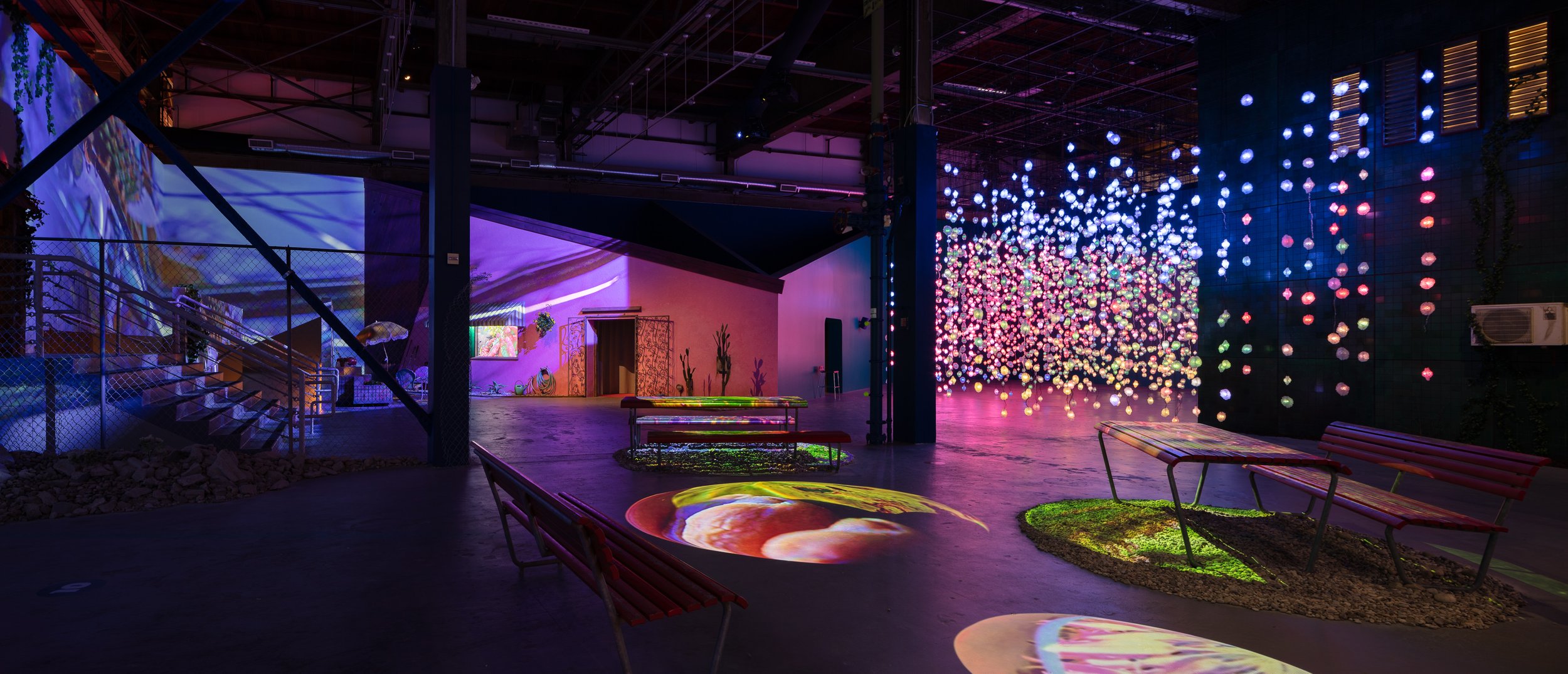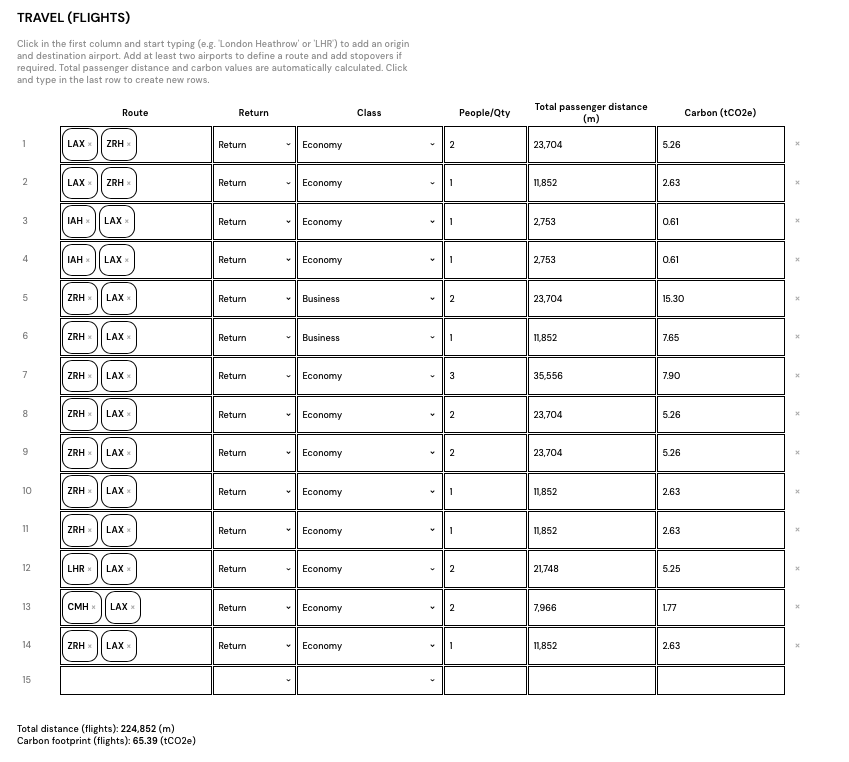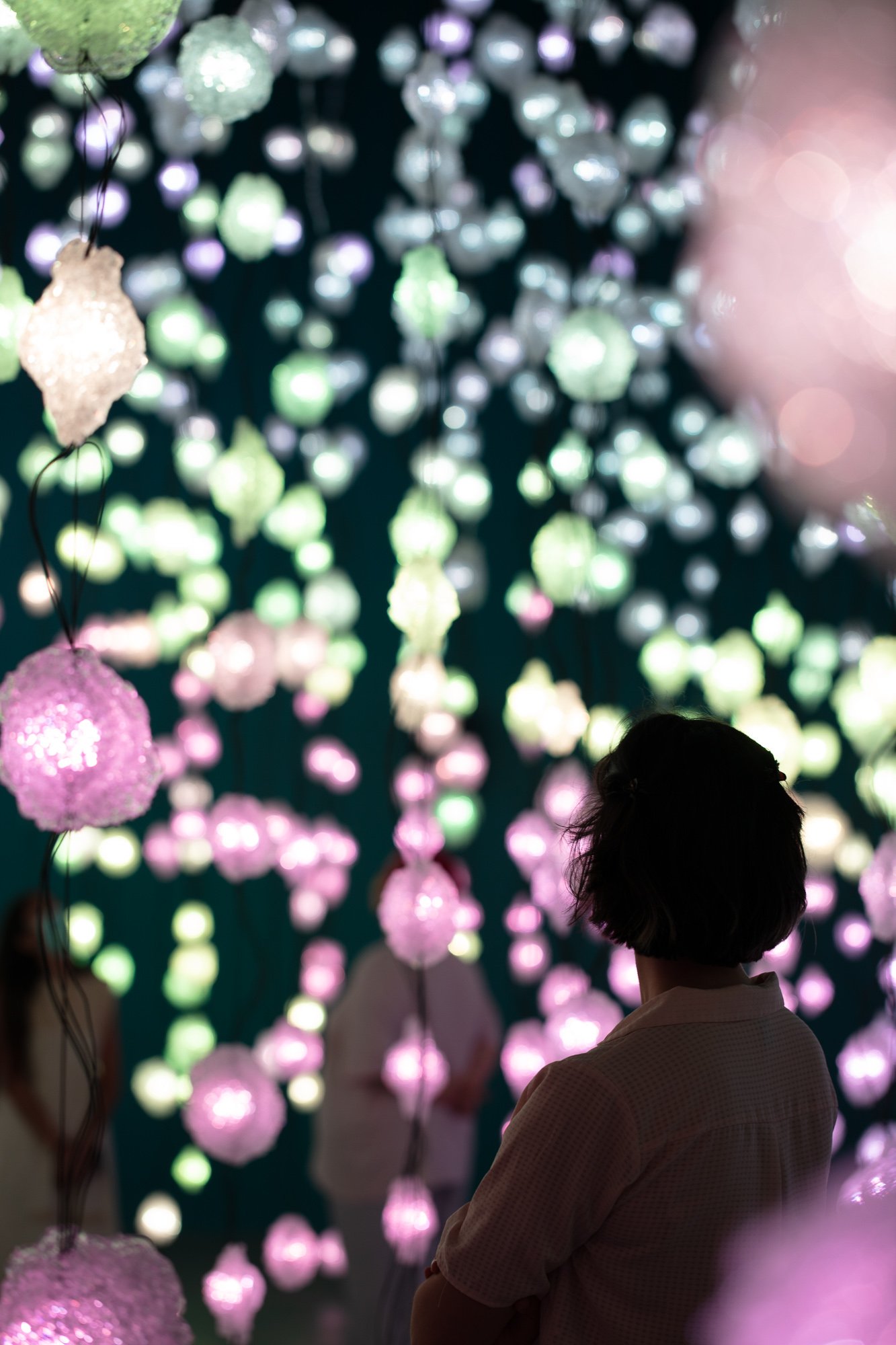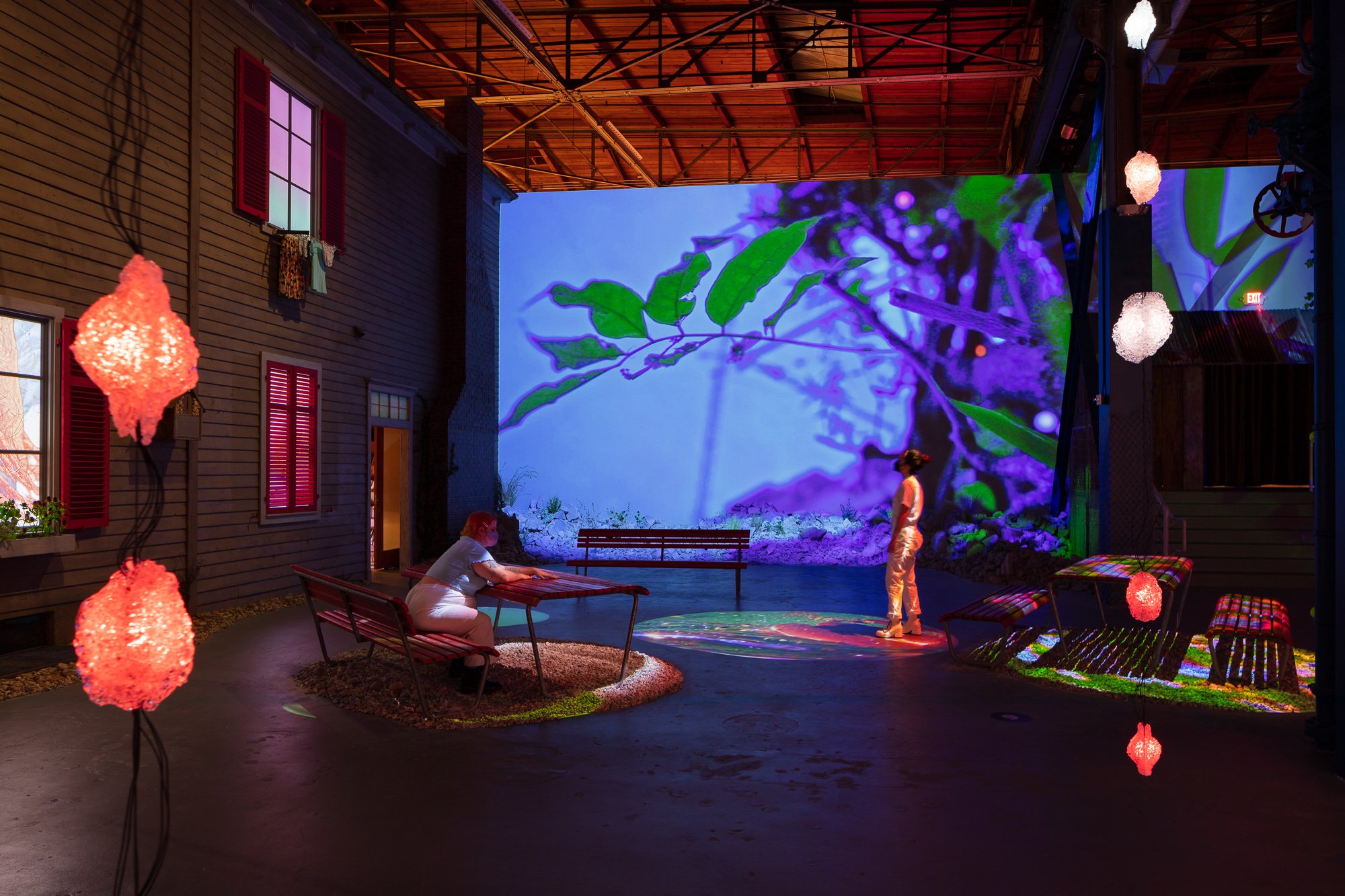PIPILOTTI RIST | THE MUSEUM OF CONTEMPORARY ART, LOS ANGELES
Installation view of Pipilotti Rist: Big Heartedness, Be My Neighbor, September 12, 2021–June 6, 2022 at The Geffen Contemporary at MOCA. Courtesy of The Museum of Contemporary Art. Photo by Zak Kelley.
Pipilotti Rist: Big Heartendness, Be My NeighborTHE MUSEUM OF CONTEMPORARY ART, LOS ANGELESSeptember 12, 2021 - June 6, 2022Introduction
Pipilotti Rist: Big Heartedness, Be My Neighbor opened at MOCA on September 12, 2021 as the museum’s first net-zero exhibition. The exhibition surveys more than thirty years of the Swiss artist’s work, encompassing early single-channel videos, large-scale installations, and a new audio-video installation made specifically for The Geffen Contemporary at MOCA. The museum collaborated with Rist to ensure an environmentally-responsible exhibition and achieve a low carbon footprint by sourcing local recycled material, shipping works by ocean containers, and serving a climate-conscious menu for the opening night dinner. What could not be reduced was assessed through a carbon audit and offset by the purchase of REDD+ carbon offsets targeting the protection of historic carbon stores. The Rist Studio offsets its studio practices and plans in a manner to lower air travel. The exhibition’s Climate Impact Report will be published on the sustainability platform Artists Commit.
Presenting Partner Climate Policy
In 2021, MOCA made a net-zero carbon declaration and is proceeding with plans to cut its direct carbon emissions by more than 50% by 2030, in alignment with the Paris Agreement and with the Gallery Climate Coalition (GCC) and Partners for Arts Climate Targets (PACT) standards. The museum aims to draw down its historic carbon footprint, back to the museum’s founding in 1979, with the goal of negating historical carbon emissions by 2023. To start, the museum is focusing on carbon reduction through infrastructure, aided by grants received from the Los Angeles Low Carbon Leaders Pilot Program (2021) to scope all reduction opportunities, and from the Frankenthaler Climate Initiative (2021) to support a shift to solar energy at The Geffen Contemporary at MOCA. The museum is reviewing its operations, implementing sustainable and circular practices both internally and through the contractors engaged to reuse building and exhibition materials, employing climate-responsible shipping, reducing plastic in catering and retail spaces, and realizing recycling and waste reductions which includes supporting sustainable food practices and the adoption of organics recycling. MOCA also plans to expand access to public transport support for staff.
Energy as a carbon reduction method has been a part of the museum’s historical sustainability actions. In 2017, MOCA modernized its HVAC system, replaced all lighting with LED fixtures, and installed a new Digital Energy Management System at the Grand Avenue location. These renovations, led by Rosenberg + Associates, reduced electricity consumption by more than 50% and water use by 90% without varying temperature or humidity by more than 1% during the project. In 2020, the museum began an institution-wide carbon audit with The Carbon Accounting Company based on the Greenhouse Gas Protocol to learn where reductions and improvements can be made. The real-time audit engages all available emissions data from travel, events, shipping, building materials and energy records since the museum’s inception and is a part of the museum’s net-zero commitment. The museum will publish an annual Environmental Sustainability Report on its website to share its progress.
MOCA supports fellow initiatives that work with sustainability measures, capacity building, and museum policy ideas. In 2020 and 2021, the museum worked, supported and/or sustained dialogues with Barder.art, Art to Zero, Gallery Climate Coalition, Galleries Commit, Art and Climate Action, Culture Declares Emergency, and Ki Futures. MOCA is focusing on employee-led sustainability, recognizing that the museum staff will be the biggest asset in advancing sustainability in the museum practice with contracts with Art to Zero and Ki Futures in 2021. MOCA joined the Gallery Climate Coalition (GCC), a non-profit organization founded to help the art world reduce its impact on the climate and to develop a meaningful, industry-specific response to the growing climate crisis, and supported the formation of a GCC LA chapter. A museum goal is to participate in capacity building at Los Angeles peer institutions through resource sharing. In this vein, many of the materials used by the museum for sustainability planning and audits will be posted publicly on its website.
Exhibition Overview
Pipilotti Rist: Big Heartedness, Be My Neighbor is the first West Coast survey of the internationally renowned Swiss media artist. Rist’s installations explore relationships of video and the body; exterior environments and interior psychological landscapes; and reason and instinct. They exuberantly probe the video medium’s capaciousness—for vivid color; sweeping views and extreme close-ups; introspection and cultural critique; and, importantly, the creation of shared experiences within the public space of the museum. The exhibition surveys more than thirty years of the Zürich-based artist’s work, encompassing early single-channel videos; large-scale installations brimming with color and hypnotic musical scores; and sculptures that merge everyday objects, video, and decorative forms. The exhibition debuts a new audio-video installation made specifically for The Geffen Contemporary at MOCA. The exhibition is organized by Anna Katz, Curator, with Karlyn Olvido, Curatorial Associate, The Museum of Contemporary Art, Los Angeles. Lead support is provided by Marina Kellen French and The Anna Maria & Stephen Kellen Foundation. Major support is provided by The Aileen Getty Foundation. Generous support is provided by The Eli and Edythe Broad Foundation. Additional support is provided by MOCA Projects Council, Marguerite Steed Hoffman, Robert Soros, and Pro Helvetia. Exhibitions at MOCA are supported by the MOCA Fund for Exhibitions with generous funding provided by Judith Angerman, Earl and Shirley Greif Foundation, Nathalie Marciano and Julie Miyoshi. In-kind support is provided by Kvadrat. In-kind media support is provided by KCRW 89.9 FM. This is the museum's first net-zero exhibition with support from the MOCA Environmental Council.
Carbon Emissions
The exhibition’s carbon emissions were assessed according to the categories listed below using the Gallery Climate Coalition calculator. These estimates are not comprehensive given all of the interdependencies involved, however, efforts have been made to be as accurate as possible in the spirit of transparency. This carbon calculation focuses on large-emitting aspects of the exhibition and is not a comprehensive calculation. While Scope 1 - 3 carbon was considered, aspects of the calculation may change in the future as the exhibition is currently ongoing. In addition, many granular aspects of creating an exhibition are missed in this calculation, and for this reason the exhibition is double offset.
The exhibition comprises an estimated 45.6% of the interior building space at The Geffen Contemporary at MOCA and building and administrative space energy use for this time is calculated at approximately 132.72 tCO2e, which is included in the institutional annual audit published by GCC. Energy usage for the duration of the exhibition including installation and deinstallation, has been calculated with actual utility usage for February 2020 through August 2021. Assumptions for utility usage from September 2021 through June 2022 have been estimated using 2019 utility data.
Gallery Climate Coalition carbon calculation for building energy.
The exhibition carbon emissions were double offset by A) standard carbon offsets in a conservation forest project in Borneo titled Katingan Mentaya, the world's largest REDD+ project, overseen by VERRA, and B) through a donation to the Galleries Commit X Art into Acres permanent land conservation support of the Chuyapi Urusayhua Regional Conservation Area in Peru overseen by the Andes Amazon Fund. Both projects protect historic stores of sequestered carbon.
Transportation: 65.68+ tCO2e
18 round trip international flights, 4 round trip domestic flights, and 94 car trips totaling 65.68+ tCO2e were taken to plan, install and de-install the exhibition. Of the flights, 8 were related to project development, and 14 were related to artwork production, installation and deinstallation. Due to Covid-19 travel restrictions, a portion of the exhibition’s planned travel was eliminated and replaced by digital planning.
Gallery Climate Coalition carbon calculation for travel (flights).
Gallery Climate Coalition carbon calculation for taxi travel.
Artwork Energy Use: 1.40+ tCO2e
More information forthcoming after the close of this exhibition. The exhibition encompassed early single-channel videos in addition to a new audio-video installation made specifically for The Geffen Contemporary. The artwork's energy source is the general grid electrical purchased by the museum. The museum is currently in the process of shifting to solar.
Shipping: 10.47+ tCO2e
The Rist studio eliminated almost all air freight due to the carbon footprint and shifted transport exclusively to land and sea freight. The exhibition produced a minimum of 9.36 tCO2e from sea freight, mainly containers from Europe to Los Angeles, and a minimum of 1.11 tCO2e from land freight, mainly crates being transported from the MOCA warehouse to the Geffen building for installation. Rist made a concerted effort to source re-used and reusable material from secondhand stores for the exhibition locally in Los Angeles, which also reduced shipping. These efforts were done to increase the efficiency of the exhibition budget and to reduce the exhibition carbon budget. There are limitations on the accuracy of the calculation methodology, as most air freight and sea freight shipments also include a road transfer portion, and the road freight calculation used does not account for vehicle type. There were smaller parcels containing equipment and accessories that shipped directly from vendors to MOCA that were not calculated. This figure does not reflect all shipping-related emissions such as any volume under 1% of gross exhibition weight. This calculation does include the outbound shipping at the close of the exhibition which was prefigured by Meridith Gray, Director of Registration and Collections, and Jill Davis, Senior Director, Exhibition and Collections for this report.
Gallery Climate Coalition carbon calculation for sea freight.
Gallery Climate Coalition carbon calculation for road freight.
Food: 3.94+ tCO2e
The exhibition opening dinner was provided by Hauser & Wirth, via their local restaurant Manuela, and had vegetarian and pescatarian options to reduce the carbon emissions and improve the ethical concerns around animal treatment as connected to this exhibition. Research prior to the meal was conducted and the Rist dinner, and surrounding education, has prompted conversations about an all-vegan meal for the next museum benefit.
Calculated Carbon Emissions: 81.49+ tCO2e*
*See attached images below for line items of carbon emission calculations.
Areas Not Calculated
Additional areas where the project was not able to accurately assess carbon emissions at the time of publication include project-related staff commutes, visitor travel, related events, related printing and marketing materials and emissions related to the production of the artwork and related materials, among other areas.
Waste Report
The exhibition had waste to landfill. ✓
Materials used in the exhibition have been categorized by waste type. It is an accounting of all waste materials related to 3% or greater of the exhibition waste generated by volume. It is important to note that this exhibition hasn't been completely closed out yet so there will be additional work looking at refuse and recycling from the exhibition once it has run its course and comes to a close. There are plans to have a vendor remove reusable material for set building. This will come at a fee covered in addition to the normal deinstallation expenses.
Reuse: (material to be reused for the same purpose as the original use)
Crates
Computer servers
Grid from Pixelforest
The crates, computer servers and the grid from Pixelforest will be reused in the future by the current owners. Reuse of these materials will require crating, shipping and storage.
Repurpose: (to be kept, sold, or donated)
Facades, Rocks, Faux Plants & Props, Carpet from Sip & Ever, Wall studs
Materials purchased from local Los Angeles thrift stores and other establishments will be repurposed. The studs from the exhibition wall construction will be donated and reused for future wall/ rough building construction. This section will be further elaborated on after the close of the exhibition.
Storage: (items sent to storage without a clear plan for immediate reuse or repurpose)
Exhibition materials shipped from Artist’s studio
Everything that was shipped from the artist’s studio and studio storage by sea freight will be returned to the studio, except for the carpet. This section will be further elaborated on after the close of the exhibition.
Recycling: (items which will be recycled)
Drywall
Exhibition carpet
The drywall from the exhibition wall construction will be recycled. These materials are not suitable for museum wall construction reuse. Simone Paz, MOCA Sustainability Consultant, is reviewing the potential reuse, donation or recycling of the carpet. The carpet was purchased for the exhibition by the studio and will be lightly used upon close of the exhibition. This report will be updated after the close of the exhibition as to the final recycling/ donation/ reuse location.
Landfill: (items requiring landfill disposal)
To be determined
This section of the report will be updated at the close of the exhibition as to the final waste/ reuse state of the exhibition materials.
Supporting People
The project adopted the following practices to support the people working on it:
Prioritize working with BIPOC, femme-identified, LGBTQ+ owned businesses and individuals. ✓
Prioritize working with vendors who support climate action. ✓
Consider economic models which keep wealth within communities. ✓
Create spaces free of racism, harassment and other forms of inequity. ✓
Encourage climate-minded thinking within the project team. ✓
Consider inclusion and needs of local communities in the project. ✓
Collective Action
The project supported collective action within the art sector in the following ways:
Share a climate case study at artistscommit.com. ✓
Use this case study as a framework or model available to other artist projects hosted by the presenting partner. ✓
Share what was learned in the case study to audiences. ✓
Ask project partners and collaborators about their climate policies, commitments, or priorities. ✓
Other: Use this case study to refine future practices. ✓
Additional Notes
Other actions taken or areas the project engaged in climate-conscious approaches, key findings that were learned, successful strategies implemented, challenges faced, or areas for future improvement:
By filling out this Climate Impact Report (CIR), strategies were learned and reflected on for future engagement. For the museum’s next CIR, we will distribute the CIR form at the outset, which will likely help all team members align with the active goals in a common shared location (document) and report throughout the process. This will have a sizeable impact on waste reduction, as the waste reduction aspect of this report was quite helpful for active reflection and shifts in behavior.
Exhibition Basic Info and Credits
Report Date: October 10, 2021
Exhibition Category: Solo
Link to Project: https://www.moca.org/exhibition/pipilotti-rist
Exhibition Artist: Pipilotti Rist
Exhibition Title: Pipilotti Rist: Big Heartedness, Be My Neighbor
Presenting Partner: Museum of Contemporary Art, Los Angeles
Exhibition Address: Geffen Contemporary Building 5, 152 N Central Ave, Los Angeles, CA 90012
Exhibition Dates: September 12, 2021–June 6, 2022
Exhibition Size: Approximately 19,825 Square Feet
Curated by: Anna Katz, MOCA Curator, with Karlyn Olvido, MOCA Curatorial Associate
Carbon Emissions Metrics Prepared by: Meridith Gray, Director of Registration and Collections, Jill Davis, Senior Director, Exhibition and Collections
Waste Metrics Prepared by: Patrick Weber, MOCA Operations Director
CIR Prepared by: Haley Mellin, MOCA Environmental Council
CIR Audited by: Simone Paz, MOCA Sustainability Consultant
CIR Reviewed by: Anna Caruso, Hauser & Wirth; Nike Dreyer, Pipilotti Rist Studio

















